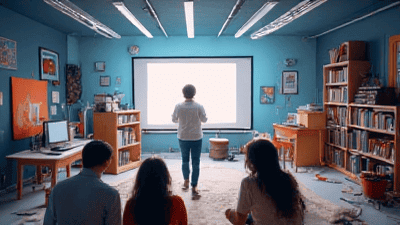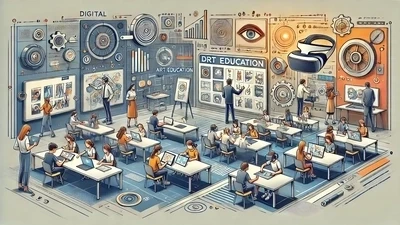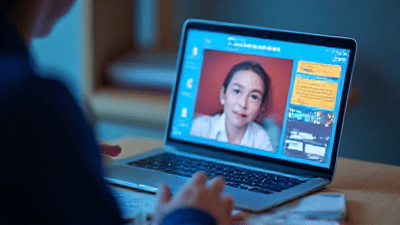
The rapid evolution of technology has transformed every aspect of our lives, including education. In the realm of the arts, the integration of digital tools opens new avenues for creativity and expression. The digital age is not just about the utility of technology; it is about how these tools can amplify our creativity and enhance the teaching of arts.
The Importance of Teaching Arts in the Digital Age
1. Fostering Creativity
Creative thinking is essential in the 21st century. The ability to innovate and approach problems from different perspectives is increasingly valued across various fields.
Nurturing Imagination: Arts education encourages students to imagine, create, and express themselves in unique ways. Digital tools provide new mediums for artistic expression, expanding the boundaries of creativity.
Problem Solving: Engaging in artistic processes teaches students to approach challenges with an open mind. They learn to experiment, revise, and adapt, which enhances their problem-solving skills—critical in any discipline.
2. Enhancing Engagement
In a world where attention spans are often limited, engaging students is vital. Arts education offers a powerful avenue for capturing interest.
Interactive Learning: Digital tools enable interactive learning experiences that can captivate students. Engaging with technology allows students to explore art in ways that are exciting and relevant.
Variety of Mediums: The digital age allows for the exploration of diverse artistic mediums, from digital painting and graphic design to video production. This variety can appeal to a wider range of student interests and talents.
3. Preparing for the Future
As we move further into the digital era, preparing students for future careers is essential.
Industry Relevance: Many creative industries rely heavily on technology, from animation and game design to digital marketing and multimedia arts. Teaching arts in the digital age aligns educational practices with industry demands.
Skill Development: Exposure to digital tools and techniques enables students to acquire skills highly sought after in today’s job market. Familiarity with software and technologies relevant to the arts bolsters their employability.
4. Building Cultural Awareness and Expression
Arts education fosters cultural understanding and personal expression.
Global Perspectives: Digital tools allow students to access and engage with art from different cultures worldwide. This broadens their understanding of global perspectives and societal contexts, fostering empathy and respect.
Self-Expression: The arts serve as a powerful vehicle for self-expression. In a world that increasingly values individual voices, teaching arts digitally allows students to use technology to tell their stories and share their unique identities.
Effective Strategies for Integrating Technology into Art Education
1. Embrace Digital Tools
Art educators should familiarize themselves with various digital tools that can enhance the learning experience.
Art Software: Programs like Adobe Creative Suite, Procreate, and Corel Painter allow students to experiment with digital painting, graphic design, and photo editing. Understanding these tools prepares students for careers that require technical proficiency.
Online Platforms: Websites such as Canva and Pixlr offer user-friendly interfaces for graphic design, making it easier for students to create stunning visuals without extensive training.
2. Incorporate Multimedia Projects
Encouraging students to engage in multimedia projects can enhance their learning experiences.
Video Arts: Students can create short films, animations, or documentaries using digital video editing software. This not only fosters creativity but also teaches technical skills related to filmmaking.
Web-Based Art Displays: Utilizing platforms like Behance or ArtStation allows students to showcase their work online, reaching broader audiences and gaining valuable feedback from peers and professionals.
3. Utilize Online Resources
The vast array of online resources can enhance art education significantly.
Tutorials and Webinars: Numerous online platforms provide tutorials ranging from basic drawing techniques to advanced digital production. Incorporating these resources into the curriculum allows students to learn from experts worldwide.
Virtual Galleries and Museums: Virtual tours of galleries and museums expose students to renowned artworks and artists, enriching their understanding of art history and contemporary practices without geographical constraints.
4. Encourage Collaborative Projects
The digital age promotes collaboration among students locally and globally.
Group Projects: Utilize platforms such as Google Workspace or Miro to facilitate collaborative art projects. Students can work together on designs, illustrations, and multimedia presentations, fostering teamwork and communication skills.
International Collaborations: Connecting with schools in other countries allows students to collaborate on cross-cultural projects, enhancing their art education experience and building global connections.
5. Promote Experiential Learning
Experiential learning reinforces concepts taught in the classroom.
Workshops and Masterclasses: Invite guest artists or experts to conduct workshops, offering students hands-on experience with new techniques and tools.
Field Trips: Virtual field trips to art exhibitions or artist studios can offer valuable insights and inspiration. Students can engage with artists and ask questions, fostering a deeper connection to their work.

The Benefits of Digital Tools in Art Education
1. Increased Accessibility
One of the most significant advantages of digital tools is accessibility.
Cost-Effective Solutions: Digital art tools often provide affordable or free options for students. Access to software and online resources means that students do not need expensive materials to create art.
Remote Learning Opportunities: In an increasingly digital world, online learning has become a viable option for students, providing access to quality art education regardless of location.
2. Enhanced Collaboration
Digital tools facilitate collaboration among students and educators.
Real-Time Feedback: Many digital platforms enable timely feedback, allowing students to receive constructive criticism and refine their work rapidly.
Peer Review: Collaborative platforms enable peer reviews. Students learn from one another, expanding their perspectives and developing their critical thinking skills.
3. Development of Technical Skills
As students engage with digital tools, they acquire valuable technical skills.
Software Proficiency: Gaining proficiency in design software and tools prepares students for future careers while enhancing their overall educational experience.
Adaptability: Familiarity with evolving technologies fosters adaptability. Students learn to navigate new tools and software, preparing them for a constantly changing job market.
4. Encouragement of Individual Expression
Digital tools empower students to explore personal expression.
Personalized Projects: The flexibility of digital tools allows students to tailor projects to their interests, resulting in more meaningful and engaging artwork.
Diverse Mediums: Digital art offers options from photography to graphic novels, enabling students to explore a wide range of styles and techniques.
5. Preservation of Artwork
Digital tools enable students to document and share their work easily.
Digital Portfolios: Students can create online portfolios showcasing their artistic journey, making it easier to apply for scholarships, internships, or jobs in creative fields.
Social Media: Sharing artwork on social media platforms enhances visibility and can lead to opportunities for feedback, networking, and community building.
Challenges in Teaching Arts in the Digital Age
1. Technology Access and Equity
Despite the benefits, not all students have equal access to technology and the internet.
Addressing the Digital Divide: Schools and communities must work to bridge this gap by providing resources such as devices and internet access to ensure all students can fully participate in digital art education.
2. Technology Overload
With the vast array of digital tools available, educators may find it challenging to determine which tools and platforms to use.
Focus on Essentials: Teachers should prioritize a few key digital tools that align with learning objectives, ensuring that students can master them without feeling overwhelmed.
3. Balancing Digital and Traditional Techniques
While digital tools offer numerous advantages, traditional techniques remain crucial in art education.
Integrative Approach: Educators should strive for a balanced curriculum that incorporates both digital and traditional art techniques. This ensures students develop a well-rounded artistic foundation.
4. Maintaining Creativity in a Digital Space
Creating in a digital environment can sometimes feel restrictive or uninspired.
Encouraging Experimentation: Teachers can foster creativity by encouraging students to experiment with different styles and approaches rather than adhering to predefined methods. Allowing freedom in exploration promotes innovation.
5. Ensuring Authenticity
As technology becomes more accessible, concerns about authenticity and originality arise.
Emphasizing Ethics: Educators must instill values around originality and ethical practices, teaching students to respect copyright laws and recognize plagiarism in the digital age.
Best Practices for Educators
1. Continuous Professional Development
Educators must stay updated on emerging technologies and teaching strategies.
Workshops and Conferences: Participating in workshops and conferences related to digital tools and arts education can enhance teachers’ skills and improve their ability to integrate technology effectively.
2. Create a Supportive Learning Environment
A positive and encouraging classroom environment fosters creativity.
Encourage Risk-Taking: Teachers should create an atmosphere where students feel comfortable experimenting and sharing their artistic ideas without fear of judgment.
3. Foster Community Engagement
Connecting with local artists, galleries, and art organizations can enrich students' learning experiences.
Partnerships: Collaborating with local art institutions can provide additional resources, exhibitions, and mentorship opportunities for students.
4. Assessing Student Progress
Implementing diverse assessment methods can provide a comprehensive view of student growth.
Portfolios: Evaluate students through portfolios that showcase their artistic development over time, allowing for a more holistic understanding of their skills and progress.
Self-Assessment: Encourage students to reflect on their growth and identify areas for improvement through self-assessment techniques.
5. Emphasizing the Artistic Process
Recognizing the importance of the artistic process promotes growth and learning.
Focus on Journey: Educators should emphasize the value of the creative journey rather than just the final product. This encourages students to appreciate the learning that occurs throughout the artistic process.
Conclusion
Unlocking creativity through arts education in the digital age is essential for preparing students for a dynamic future. As technology continues to evolve, integrating digital tools into art education offers opportunities for innovation, collaboration, and personal expression. Although challenges exist, the benefits of teaching arts digitally are profound.
By embracing new technologies while fostering traditional techniques, educators can create a rich and immersive learning experience that empowers students to explore their creativity and express themselves authentically. In an increasingly complex world, nurturing creativity through arts education cannot be overstated. As we continue to unlock the doors of creativity, we must ensure that every student has the opportunity to embark on their artistic journey.



